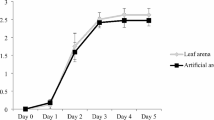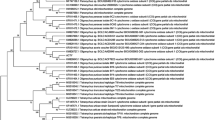Abstract
Tetranychus urticae is one of the most damaging tetranychid mites affecting clementine orchards in Spain, where natural control is insufficient. Furthermore, in clementine nurseries, tender foliage is highly susceptible to attack and natural enemies are almost always absent. Therefore, acaricides are often used indiscriminately. Alternative control measures are necessary, both in commercial orchards and clementine nurseries. In order to assess the efficacy of inoculative releases of N. californicus and P. persimilis to reduce T. urticae populations in young Spanish clementine plants, a semi-field experiment was conducted and repeated in three seasons (spring, summer and autumn). Phytoseiulus persimilis was highly effective in reducing both T. urticae infestations and the damage level inflicted on plants at both release rates evaluated (40 and 80 phytoseiids/plant) and all three periods considered. By contrast, N. californicus demonstrated low performance under certain conditions. The results of this study could be adapted and transferred to nurseries and young citrus plantations.




Similar content being viewed by others
References
Abad-Moyano R, Pina T, Dembilio O, Ferragut F, Urbaneja A (2009a) Survey of natural enemies of spider mites (Acari: Tetranychidae) in citrus orchards in eastern Spain. Exp Appl Acarol 47:49–61
Abad-Moyano R, Pina T, Ferragut F, Urbaneja A (2009b) Comparative life history traits of three phytoseiid mites associated to Tetranychus urticae (Acari: Tetranychidae) colonies on clementine orchards in eastern Spain. Implications on biological control. Exp Appl Acarol 47:121–132
Abad-Moyano R, Urbaneja A, Schausberger P (2009c) Intraguild interactions between Euseius stipulatus and the candidate biocontrol agents of Tetranychus urticae in Spanish clementine orchards, Phytoseiulus persimilis and Neoseiulus californicus. Exp Appl Acarol. doi:10.1007/s10493-009-9278-7
Abbott WS (1925) A method of computing the effectiveness of an insecticide. J Econ Entomol 18:265–267
Agustí M (2000) Citricultura. Ediciones Mundi-Prensa, Madrid
Akaike H (1974) A new look at the statistical model identification. IEEE Trans Autom Control 19:716–723
Ansaloni T, Pascual-Ruiz S, Hurtado MA, Jacas JA (2008) Can summer and fall vegetative growth regulate the incidence of Tetranychus urticae Koch on clementine fruit? Crop Prot 27:459–464
Aucejo-Romero S, Gómez-Cadenas A, Jacas-Miret JA (2004) Effects of NaCl-stressed citrus plants on life-history parameters of Tetranychus urticae (Acari: Tetranychidae). Exp Appl Acarol 33:55–68
Bolckmans K, Belda JE (2009) Producción de enemigos naturales. In: Jacas JA, Urbaneja A (eds) Control biológico de plagas agrícolas. Phytoma España, Valencia, pp 477–484
Castagnoli M, Simoni S (2003) Neoseiulus californicus (McGregor) (Acari Phytoseiidae): survey of biological and behavioural traits of a versatile predator. Redia 86:153–164
Croft BA, Monetti LN, Pratt PD (1998) Comparative life histories and predation types: are Neoseiulus californicus and N. fallacis (Acari: Phytoseiidae) similar type II selective predators of spider mites? Environ Entomol 27:531–538
Ferragut F, García-Marí F, Costa-Comelles J, Laborda R (1987) Influence of food and temperature on development and oviposition of Euseius stipulatus and Typhlodromus phialatus (Acari, Phytoseiidae). Exp Appl Acarol 3:317–329
Friese DD, Gilstrap FE (1985) Prey requirements and developmental times of three phytoseiid species predaceous on spider mites. Southwest Entomol 10:83–88
Gilstrap FE, Friese DD (1985) The predatory potential of Phytoseiulus persimilis, Amblyseius californicus, and Metaseiulus occidentalis (Acarina: Phytoseiidae). Int J Acarol 11:163–168
González-Fernández J, de la Peña F, Hormaza JI, Boyero JR, Vela JM, Wong E, Trigo MM, Montserrat M (2008) Alternative food improves the combined effect of an omnivore and a predator on biological pest control. A case study in avocado orchards. Bull Entomol Res. doi: 10.1017/S000748530800641X
Grafton-Cardwell EE, Ouyang YL, Striggow RA (1997) Predaceous mites (Acari: Phytoseiidae) for control of spider mites (Acari: Tetranychidae) in nursery citrus. Environ Entomol 26:121–130
Hamamura T, Shinkaji S, Ashihara W (1976) The relationship between temperature and developmental period and oviposition of Phytoseiulus persimilis (Acarina: Phytoseiidae). Bull Fruit Tree Res Stn E 1:117–125
Helle W, Sabelis MW (1985a) World crop pests, vol. 1A. Spider mites: their biology, natural enemies and control. Elsevier, Amsterdam
Helle W, Sabelis MW (1985b) World crop pests, vol. 1B. Spider mites: their biology, natural enemies and control. Elsevier, Amsterdam
Lenteren JC (2001) A greenhouse without pesticides: fact or fantasy? Crop Prot 19:375–384
Lenteren JC (2003) Quality control and production of biological control agents: theory and testing procedures. CABI, Wallingford, p 327
Lenteren JC, Woets J (1988) Biological and integrated control in greenhouses. Annu Rev Entomol 33:239–269
Ma WL, Laing JE (1973) Biology, potential for increase and prey consumption of Amblyseius chilenensis (Dosse) (Acarina: Phytoseiidae). Entomophaga 18:47–60
Martínez-Ferrer MT, Jacas JA, Ripollés JL (2004) La araña roja, Tetranychus urticae: métodos de muestreo y umbrales económicos de tratamiento en clementinos. Phytoma Esp 164:53–58
Martínez-Ferrer MT, Jacas-Miret JA, Ripollés-Moles JL, Aucejo-Romero S (2006) Approaches for sampling the twospotted spider mite (Acari: Tetranychidae) on clementines in Spain. J Econ Entomol 99:1490–1499
McMurtry JA, Croft BA (1997) Life-styles of phytoseiid mites and their role in biological control. Annu Rev Entomol 42:291–321
McMurtry JA, Oatman ER, Phillips PA, Wood CW (1978) Establishment of Phytoseiulus persimilis [Acari-Phytoseiidae] in Southern-California. Entomophaga 23:175–179
Opit GP, Nechols JR, Margolies DC (2004) Biological control of twospotted spider mites, Tetranychus urticae Koch (Acari: Tetranychidae), using Phytoseiulus persimilis Athias-Henriot (Acari: Phytoseidae) on ivy geranium: assessment of predator release ratios. Biol Control 29:445–452
Opit GP, Nechols JR, Margolies DC, Williams KA (2005) Survival, horizontal distribution, and economics of releasing predatory mites (Acari: Phytoseiidae) using mechanical blowers. Biol Control 33:344–351
Rabbinge R (1985) Aspects of damage assessment. In: Helle W, Sabelis MW (eds) World crop pests, vol. 1B. Spider mites: their biology, natural enemies and control. Elsevier, Amsterdam, pp 339–347
Sabelis MW (1981) Biological control of two-spotted spider mites using phytoseiid predators. Part I: modelling the predator–prey interaction at the individual level. Agricultural Research Reports, Pudoc, Wageningen, pp 238–242
Urbaneja A, Pascual-Ruiz S, Pina T, Abad-Moyano R, Vanaclocha P, Montón H, Castañera P, Jacas JA (2008) Efficacy of some acaricides against Tetranychus urticae (Acari: Tetranychidae) and their side-effects on selected natural enemies occurring in citrus orchards. Pest Manag Sci 64:834–842
Verbeke G, Molenberghs G (2008) Linear mixed models for longitudinal data. Springer, New York
Acknowledgments
This work was partially funded by the Spanish Ministry of Science and Technology (AGL2005-07155-C03-02/AGR and AGL2008-05287-C04-01/AGR) and the Conselleria d’Agricultura, Pesca i Alimentació de la Generalitat Valenciana. Josep Jacas (UJI, Castelló, Spain) and P. Schausberger (Institute of Plant Protection, Vienna, Austria) provided useful comments on an early draft of the manuscript. The authors wish to thank H. Montón (IVIA), O. Dembilio (IVIA) and O. Mollà (IVIA) for plants care and technical support and J. Calvo and J. E. Belda (Koppert B.S., Almería, Spain) for the N. californicus and P. persimilis supply. R. Abad-Moyano was recipient of a grant from IVIA.
Author information
Authors and Affiliations
Corresponding author
Rights and permissions
About this article
Cite this article
Abad-Moyano, R., Pina, T., Pérez-Panadés, J. et al. Efficacy of Neoseiulus californicus and Phytoseiulus persimilis in suppression of Tetranychus urticae in young clementine plants. Exp Appl Acarol 50, 317–328 (2010). https://doi.org/10.1007/s10493-009-9318-3
Received:
Accepted:
Published:
Issue Date:
DOI: https://doi.org/10.1007/s10493-009-9318-3




